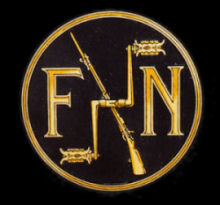

A Powerful and Flexible Machine: Mechanical Inlet Valves and Special Lubrication.
SO much has been heard about Liege of late and the gallant defence its suburb Herstal made against the Germans, that a few lines concerning the well-known products of the Belgian small arms factory, which is situated in that locality, and, as is well known, took no small part in the proceedings, will be of interest. Thanks to the courtesy of Mr. Gelder, the manager of the F.N. motor agency in London, we were given the opportunity of testing both models, the 2½ h.p. and the 7 h.p., though, owing to it being the newer of the two, we intend to deal more fully with the latter. The smaller of the two machines is a thoroughly handy and practical little mount, of medium weight, and of moderate horse-power, capable of an unlimited amount of hard work, and possessing the admirable wearing qualities for which the F.N. is famous. Our experience with it was in the streets of London, in which it acquitted itself splendidly and was a most appreciable help to us in our work. We were much interested and pleased at the smoothness and silence of the bevel drive on this machine.
Novel Points in Motor Cycle Practice.
The 7 h.p. is a great contrast to the latter. In the first place, it is an entirely new model which was only introduced at the beginning of the year, and about which as yet little has been written. At the time of its appearance at the Show it created much interest on account of the many novel features it embodied, features not necessarily new in themselves, but novel in motor cycle practice. It was the first machine to emanate from this factory which was fitted with a four-cylinder engine equipped with mechanically-operated inlet valves, and the first motor of this type to be fitted with a mechanical system of lubrication.
Add to these the gate change, the three-speed sliding gears, and the multi-disc clutch, we find points which at the time of its introduction could not be said to conform to the practice usually followed by motor cycle manufacturers. As may be imagined, with all these refinements a machine of 7 h.p. is by no means a lightweight, in fact the new four-cylinder F.N. makes no pretence of being anything but a heavy mount, and in this short article we will endeavour to show, as we have done on previous occasions, that weight matters very little on a motor bicycle.
It is only when the machine has to be wheeled about or pushed from place to [place that the extra weight is at all noticeable, and it was with the intention of trying to prove this fact that we purposely had the sidecar, with which the machine was flitted, removed. Once on the road the weight was absolutely forgotten, exactly as was anticipated. Even from dead cold the engine would start on the first or second depression of the excellently designed foot-starting device. The clutch was a little difficult to free owing to its having an extra plate, but when once warm it gave no further trouble in this respect. Changing up was not quite so easy as changing down, but no real difficulty was experienced, and it must be pointed out that the machine we were using was by no means a new one, and had seen much service. It had been originally ridden by Gosse, who had accompanied us on it most of the way of the last London- Edinburgh run.
The Latest 7h.p. Four-cylinder F.N.
We found the engine to be extremely flexible and capable of the most extraordinary powers of acceleration, which were more strongly developed than in any other machine we have yet ridden. It is with no exaggeration that we say that when the throttle was opened the saddle seemed, inclined to slide from under us. The sense of such enormous power was delightful, and, of course, greatly increased the pleasure of driving. It was not until we had left the great city behind that we were fully able to appreciate the, wonderful turn of speed the machine possessed, or to appreciate to the full the marvellous acceleration, but it suffices to say that we were entirely satisfied in both these respects.
We lunched with our friend the Rev. E. P. Greenhill in the country, who afterwards set out with us on his twin 3½ h.p. Motosacoche to climb one or two of the best known Surrey test hills. Not far from his house is Wray Lane, at the top of which we arrived. We descended to the bottom and by doing so were able to realise its severity, and then turning round sailed up without any run. The F.N. took it in excellent form, climbing all but the last portion on top gear, the second being only requisitioned for the last few yards, which are really steep. Next we went down Reigate Hill and made our way to Betchworth, whence Pebble Hill is reached. This was taken on the run, and two-thirds were covered on top speed, the rest was finished on second at certainly not less than twenty-five miles an hour, a feat which pleased us greatly. The return journey was made through Leatherhead, where we said good-bye to our companion, and Surbiton. We found the spring forks very efficient, and the machine steady and most comfortable to ride
In traffic the hand-controlled clutch was a delight to operate, the brakes were smooth in action but powerful, and the machine as a whole most satisfactory, while despite its weight and power it was very tractable. What contributed in no small measure to its extreme comfort were the 650 mm. x 75 mm. Engelbert tyres fitted, which, like the F.N., are of Belgian manufacture.
The Motor Cycle, September 10th, 1914. pp331, 332.
If you have a query or information about FN motorcycles please contact us